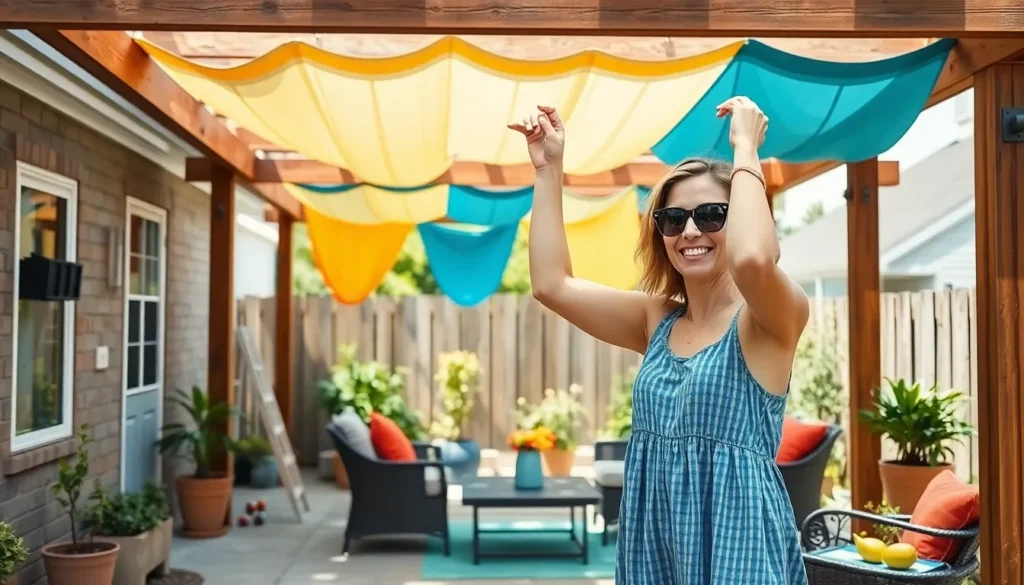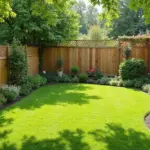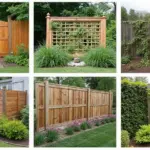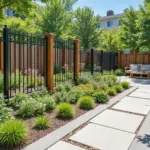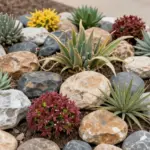We’ve all dreamed of having that perfect outdoor sanctuary where we can relax and entertain without very costly. Creating a stunning covered patio doesn’t require a massive investment or professional contractors – with the right approach and creative thinking you can transform your outdoor space into a cozy retreat that rivals expensive custom installations.
Budget-friendly covered patio answers are more accessible than you might think. From simple DIY pergolas using basic lumber to repurposing everyday materials for shade structures we’ll show you how to maximize your outdoor living potential without maxing out your credit card.
Whether you’re working with a small balcony or a spacious backyard we’ve compiled proven strategies that deliver impressive results for under $500. These practical ideas combine functionality with style proving that you don’t need to sacrifice aesthetics when you’re watching your wallet.
DIY Pergola Solutions for Affordable Shade
Building your own pergola offers the perfect balance of style and functionality while keeping costs under control. We’ve found that homeowners can create stunning shade structures for just $200-400 using basic materials and weekend effort.
Build a Simple Wooden Pergola Frame
Pressure-treated lumber provides the most cost-effective foundation for your pergola project. We recommend starting with 4×4 posts for the main supports and 2×8 boards for the horizontal beams, which typically costs $150-250 for materials.
Cut your lumber to standard dimensions to avoid additional fees at the hardware store. Most pergolas work well with 8-foot post heights and 10×12 foot footprints, creating ample coverage for standard patio furniture arrangements.
Anchor posts directly into concrete footings for maximum stability without expensive hardware. We suggest digging 24-inch deep holes and using fast-setting concrete mix, which costs about $30 and sets within 20 minutes.
Assemble the frame using galvanized carriage bolts rather than screws for stronger connections. This hardware typically adds $25-40 to your project but ensures your pergola withstands weather for years.
Install Retractable Shade Cloth
Shade cloth installation transforms your basic pergola into a functional outdoor room with 70-90% UV protection. We’ve tested various materials and found that 70% shade cloth provides the best balance of sun protection and airflow.
Mount the cloth using eye screws and cable systems for easy seasonal adjustments. Quality shade cloth costs $40-80 for a 10×12 foot area and includes grommets for simple installation.
Create a pulley system with basic hardware to make the shade cloth retractable. We use marine-grade rope and pulleys from the hardware store, adding about $25 to the total cost while providing maximum flexibility.
Secure one end permanently while making the opposite end removable for winter storage. This approach extends the cloth’s lifespan and prevents damage from snow loads or high winds.
Add Climbing Vines for Natural Coverage
Fast-growing vines create living shade that becomes more beautiful each season. We recommend starting with clematis, morning glories, or grape vines, which cost $10-20 per plant and provide coverage within one growing season.
Install a simple wire grid system between pergola posts to support vine growth. Galvanized wire mesh or tension cables work perfectly and cost under $30 for most pergola sizes.
Plant vines in spring for maximum first-year growth, positioning them 18 inches from each post. We’ve found that 4-6 plants provide adequate coverage for a standard pergola within 2-3 seasons.
Choose deciduous vines for natural seasonal variation that provides shade in summer and allows sunlight through in winter. This approach eliminates the need for retractable systems while creating year-round visual interest.
Repurpose Existing Materials for Creative Covers
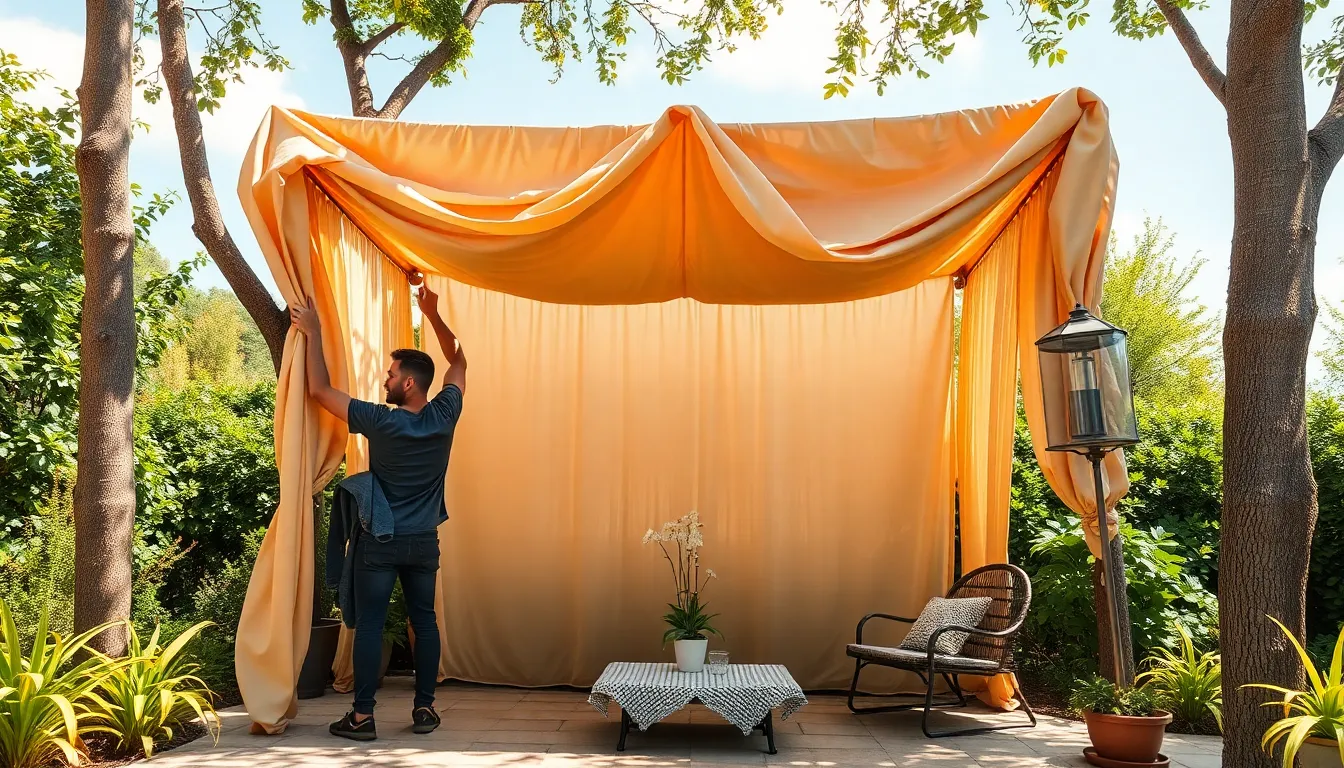
We can transform everyday household items into functional patio covers without very costly. These creative answers offer immediate shade and protection while maintaining our budget conscious approach.
Transform Old Bed Sheets into Weather-Resistant Canopies
Bed sheets from our linen closets become excellent temporary canopies with minimal investment. We simply treat them with fabric sealant or waterproofing spray to create weather resistant coverage. Draping these treated sheets between posts or trees creates an airy, casual atmosphere that’s perfect for outdoor gatherings.
Installing grommets along the edges makes securing the fabric much easier. We can thread rope through these reinforcement points and tie them to anchor points around our patio space. This method allows us to adjust the tension and height as needed while creating attractive draping effects.
Multiple sheets can be layered for increased coverage and visual interest. We recommend using lighter colored fabrics to reflect heat and maintain cooler temperatures underneath. These canopies work especially well for temporary events or seasonal use when permanent structures aren’t practical.
Use Tarps and Grommets for Quick Installation
Heavy duty tarps provide the most durable budget option for instant patio coverage. We can install these covers in under an hour using basic tools and hardware. Pre made grommets around the edges make attachment simple and secure.
Bungee cords offer the fastest connection method for temporary installations. We stretch them between grommet points and nearby posts, railings, or anchor points. This system allows for quick setup and removal when weather conditions change.
Rope connections work better for semi permanent installations where we want more control over tension. We thread the rope through grommets and use trucker’s hitches or other secure knots to maintain proper tautness. Strategic placement prevents water pooling during rain while providing maximum shade coverage.
Convert Outdoor Umbrellas into Permanent Fixtures
Large outdoor umbrellas become reliable permanent shade answers with proper anchoring techniques. We secure the umbrella pole in a concrete footing or weighted base to create stability. This approach costs significantly less than building traditional structures while providing adjustable coverage.
Concrete anchoring offers the most permanent solution for high wind areas. We dig a hole approximately 18 inches deep and set the umbrella pole in quick setting concrete. This method ensures the umbrella stays secure through storms and seasonal weather changes.
Weighted base systems work well for renters or those wanting flexibility. We use multiple sandbags or concrete blocks around a sturdy base to create sufficient weight. Market umbrellas with tilting mechanisms give us the ability to adjust shade position throughout the day, maximizing comfort and usability.
Budget-Friendly Roof Extension Ideas
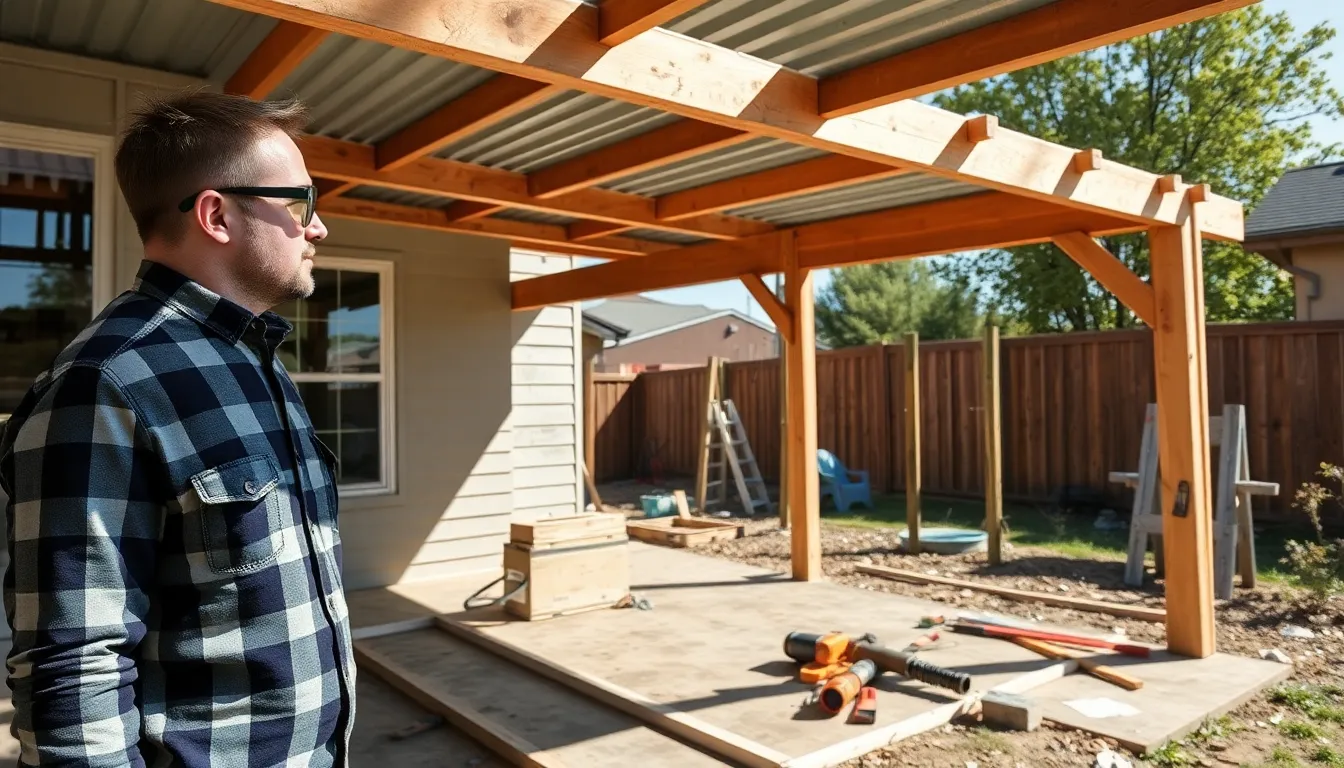
Building on our repurposed material answers, we can explore permanent roof extensions that provide comprehensive coverage at affordable prices. These structural additions offer long-term value while maintaining budget-friendly construction costs.
Attach Lean-To Structures to Existing Walls
Lean-to patio covers offer the most economical roofing solution by utilizing your home’s existing wall as structural support. We can build these single-slope covers for under $200 using basic lumber and corrugated panels. The design attaches directly to an exterior wall, eliminating the need for additional posts or complex framing.
Materials we’ll need include pressure-treated 2×6 lumber for the ledger board, 2×4 rafters, and galvanized lag bolts for wall attachment. Start by securing the ledger board to the house at the desired height, ensuring it’s level and properly anchored into wall studs. Cut rafters to span from the ledger to your desired overhang distance, creating a slope of at least 1/4 inch per foot for proper drainage.
This beginner-friendly approach provides effective shade and rain protection while requiring minimal carpentry skills. We recommend spacing rafters 16 inches on center for standard corrugated panel installation.
Install Corrugated Metal Roofing Panels
Corrugated metal panels deliver exceptional durability and weather resistance at remarkably low costs. These lightweight panels install quickly over basic lumber framing and withstand harsh weather conditions better than many expensive alternatives. Metal roofing panels typically cost $2-4 per square foot, making them significantly cheaper than traditional roofing materials.
We can choose from galvanized steel, aluminum, or polycarbonate corrugated panels depending on our exact needs and budget. Steel panels offer maximum durability, while polycarbonate options allow filtered light to pass through. Install panels by overlapping edges by one corrugation and securing with appropriate screws every 12-18 inches along the rafters.
For enhanced appearance, we can paint metal panels with exterior-grade paint to match our home’s color scheme. This upgrade costs minimal additional money while dramatically improving the overall aesthetic appeal.
Create Slanted Covers Using Basic Lumber
Slanted roof covers combine stylish design with economical construction using simple lumber framing techniques. We can build these structures either attached to existing buildings or as freestanding covers, accommodating various lot configurations and budget constraints. The slanted design effectively directs rainwater away from seating areas while creating an attractive architectural element.
Construction requires 4×4 pressure-treated posts, 2×8 beams, and 2×4 rafters arranged in a single-slope configuration. Set posts in concrete footings spaced 8-10 feet apart for adequate support. Connect beams to posts using galvanized carriage bolts, then install rafters at 16-inch intervals.
We can top these frames with various affordable roofing materials including metal panels, asphalt shingles, or polycarbonate sheets. This flexibility allows us to match existing home materials or choose the most cost-effective option for our exact situation.
Fabric and Canvas Covering Options
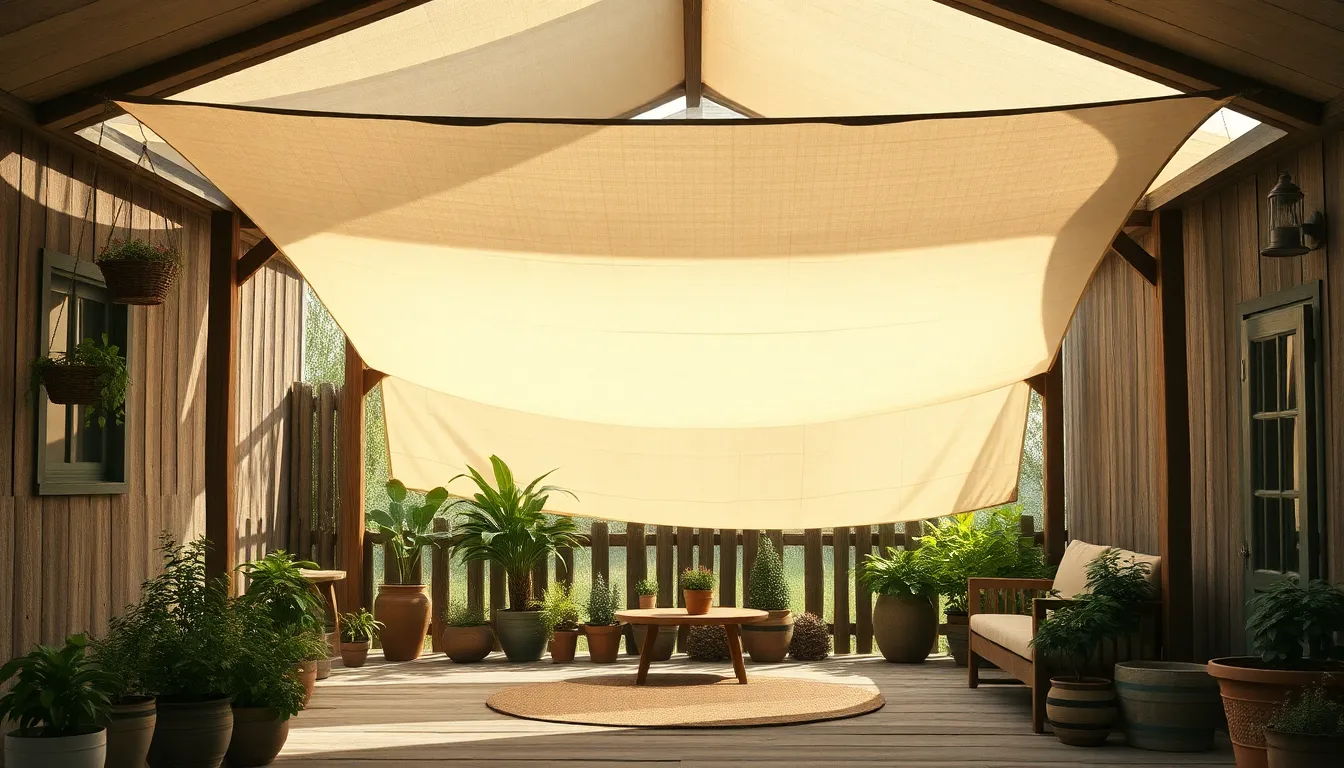
Moving beyond permanent structures, we can explore flexible fabric answers that deliver instant patio coverage without major construction. These soft covering options offer versatility and seasonal adjustability while maintaining our budget conscious approach.
Stretch Drop Cloths Across Simple Frames
Canvas drop cloths transform into excellent patio covers when stretched across basic wooden or metal pipe frames. We can purchase these affordable canvas sheets for under $30 and create custom sized shade structures that filter sunlight beautifully while maintaining airflow. Building the frame requires minimal carpentry skills using 2×4 lumber or PVC pipes connected at corners with simple brackets.
Securing the drop cloth involves creating grommets along the edges and threading rope or bungee cords through strategic anchor points. This rustic covering method costs significantly less than traditional awnings while providing that casual, farmhouse aesthetic many homeowners desire. We recommend treating the canvas with waterproof spray to extend its outdoor lifespan and prevent water damage during unexpected rainfall.
Install Outdoor Curtains on Wire Systems
Wire curtain systems create elegant covered spaces that adapt to changing weather conditions throughout the day. We can string galvanized cable between posts or existing structures and hang outdoor curtains using simple rings or clips for smooth operation. This flexible approach allows us to draw curtains closed during harsh sun or wind and pull them back when we want open air circulation.
Repurposing indoor curtains works well for budget installations, though we should choose heavier fabrics that resist fading and moisture. Marine grade vinyl or canvas curtains offer superior durability but cost more upfront. Installing turnbuckles on the wire system ensures proper tension and prevents sagging over time, maintaining a professional appearance for years.
Use Painter’s Canvas for Rustic Appeal
Painter’s canvas drop cloths deliver exceptional value as patio covering material due to their thick construction and natural weather resistance. We can drape these heavy duty canvases over pergola rafters or stretch them between posts to create charming rustic covers that complement farmhouse and cottage style homes. Canvas materials typically cost 40-60% less than specialized outdoor fabrics while providing similar sun protection.
Treating the canvas with fabric waterproofing spray enhances its ability to shed light rain and morning dew. We can customize the appearance by leaving the canvas natural for authentic rustic charm or applying fabric paint for pops of color that match our outdoor décor. Multiple canvas panels can be overlapped and secured with grommets and rope to cover larger patio areas while maintaining the budget friendly approach.
Creative Shade Structure Alternatives
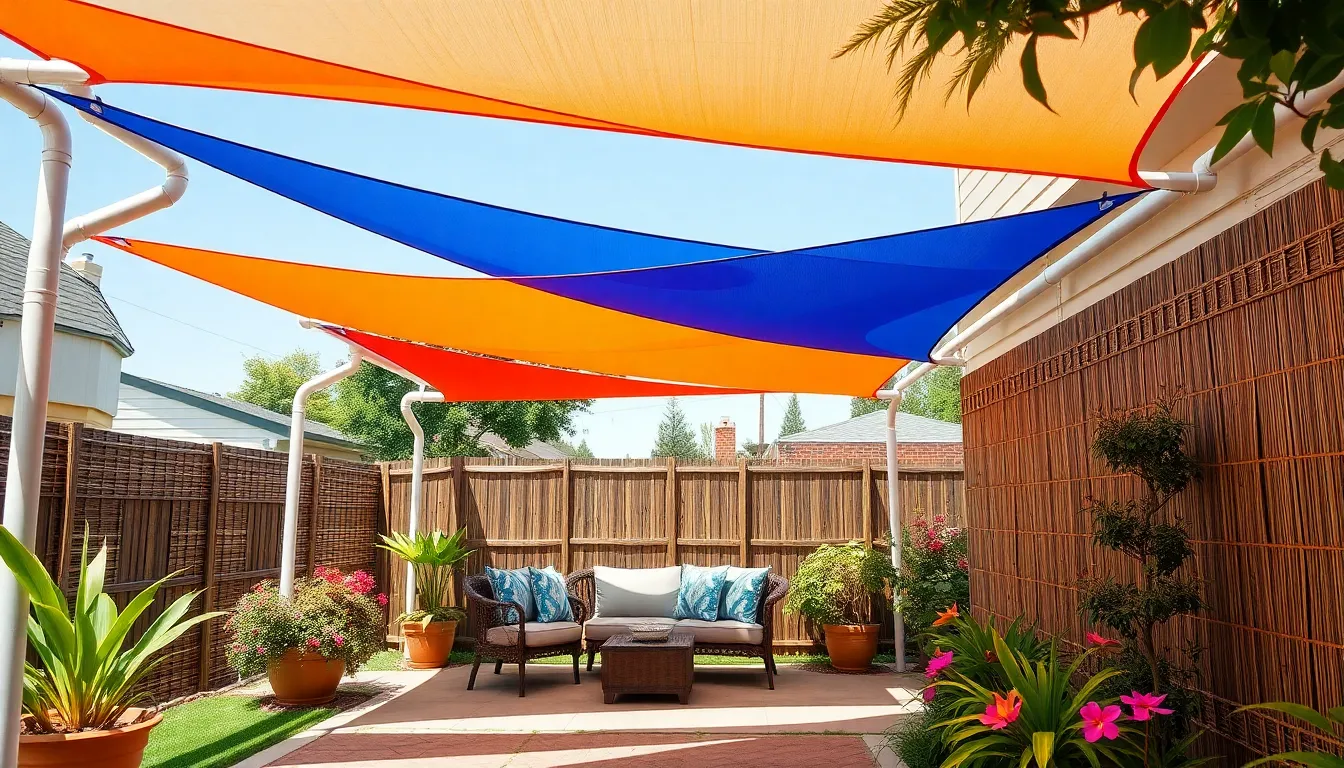
Beyond traditional roofing and fabric answers, we can explore innovative shade structures that combine style with exceptional affordability. These alternative approaches offer unique aesthetic appeal while maintaining our budget-conscious goals.
Build Bamboo Screening Panels
Bamboo screening panels deliver natural elegance at a fraction of traditional material costs. We can create stunning tropical-inspired shade structures using lightweight bamboo that’s both weather-resistant and eco-friendly. Installation requires minimal tools since bamboo panels attach easily to existing structures or custom wooden frames.
Privacy becomes an added bonus when we position bamboo screens strategically around seating areas. Airflow continues circulating through the natural gaps between bamboo slats, keeping our patio comfortable even on hot days. Maintenance stays minimal compared to wood alternatives because bamboo naturally resists moisture and insects.
We recommend purchasing pre-made bamboo panels from garden centers or creating custom screens by binding individual bamboo poles with weather-resistant ties. Frame construction uses basic 2×4 lumber to support larger installations, while smaller panels can mount directly to existing posts or walls.
Construct PVC Pipe Frame Systems
PVC pipe frames offer the most budget-friendly path to custom patio coverage. We can build entire shade structures for under $50 using standard plumbing pipes and fittings from any hardware store. Assembly requires only basic cutting and connecting skills, making this perfect for first-time DIY projects.
Versatility shines through PVC’s ability to form any shape or size we need for our exact patio dimensions. Covering options include shade cloth, outdoor fabric, or even repurposed tarps stretched across the lightweight frame. Temporary installations work perfectly since we can disassemble and store PVC structures during winter months.
Customization becomes simple when we use different pipe diameters for varying structural needs. Three-quarter-inch pipes work well for smaller covers under 8 feet, while 1-inch pipes provide stability for larger installations. T-joints and elbow fittings allow us to create complex angles and multi-level designs.
Design Sail Cloth Installations
Sail cloth installations create modern, architectural shade that transforms any patio into a stylish retreat. We achieve professional-looking results by tensioning UV-resistant fabric between anchor points like posts, trees, or existing structures. Triangle and square sails offer different coverage patterns, allowing us to customize our shade zones.
Dappled light effects emerge naturally as sail cloths filter sunlight, creating comfortable outdoor spaces without complete darkness. Installation flexibility means we can adjust tension seasonally or remove sails entirely when weather conditions change. Multiple sails can overlap for increased coverage or create ever-changing visual interest through varying heights.
Professional-grade sail cloth materials resist fading and weather damage while maintaining their attractive appearance for years. We secure installation points using heavy-duty eye bolts in posts or walls, ensuring our shade sails remain taut and stable during windy conditions. Cost effectiveness comes from sail cloth’s durability compared to annual fabric replacements needed with lesser materials.
Lighting Solutions That Won’t Break the Bank
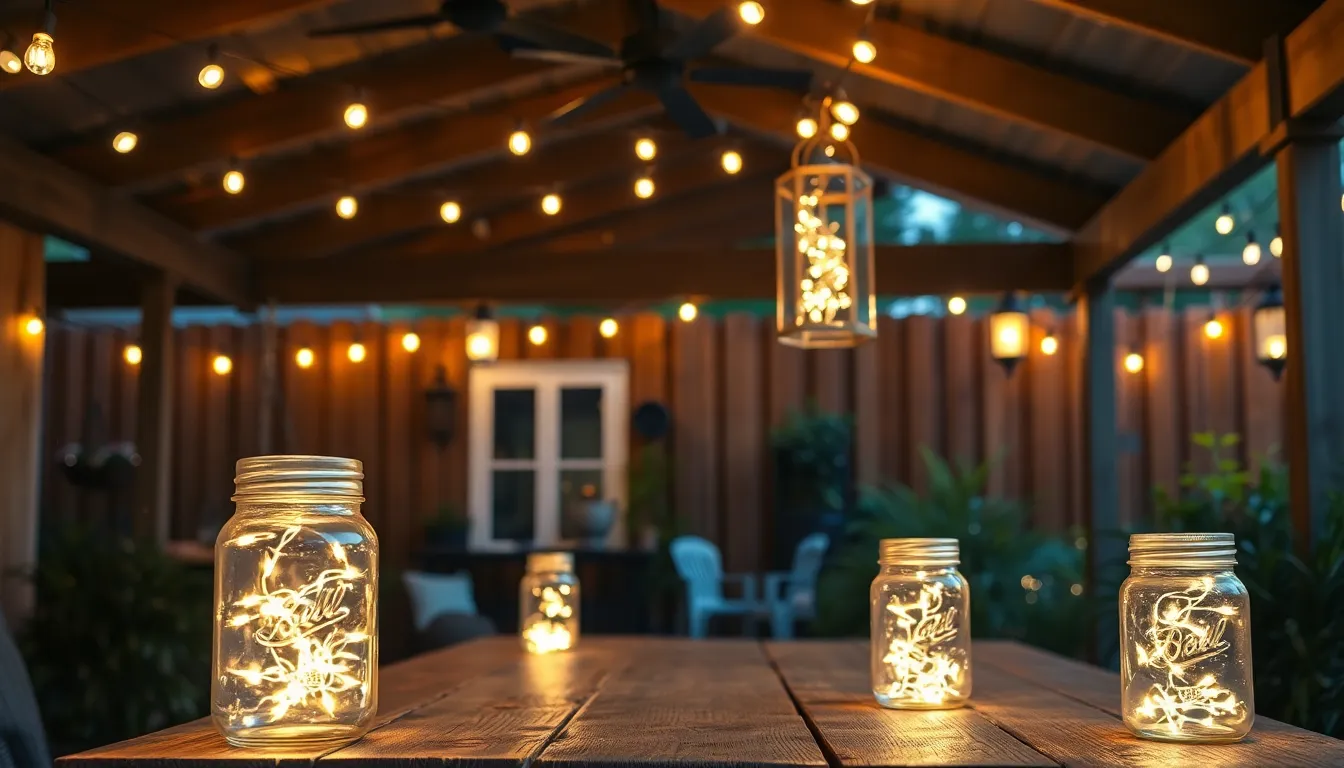
Once you’ve created your perfect covered patio structure, strategic lighting transforms the space into an inviting evening retreat. Smart illumination choices can enhance your outdoor sanctuary without adding important costs to your budget.
String Solar-Powered LED Lights
Solar-powered LED string lights offer the most cost-effective way to illuminate your covered patio while eliminating electricity expenses. These innovative lights charge automatically during daylight hours and provide ambient lighting throughout the evening without requiring electrical wiring or professional installation. We recommend draping them along pergola beams, wrapping them around support posts, or creating overhead canopies for magical evening ambiance. Modern solar LED strings last 8-10 hours per charge and withstand outdoor weather conditions year-round. Installation takes just minutes using small hooks or clips, making them perfect for renters or anyone avoiding permanent modifications.
Install Battery-Operated Lanterns
Battery-operated lanterns provide flexible lighting answers that move wherever you need illumination most. These portable fixtures eliminate the need for electrical outlets or complicated wiring while delivering soft, decorative light perfect for dining and entertaining. Position them on tables, hang them from hooks, or place them on shelves to create layered lighting effects throughout your covered space. Quality battery lanterns operate 20-40 hours on a single set of batteries and many feature timer functions for automatic operation. We suggest mixing different sizes and styles to add visual interest while maintaining consistent warm lighting across your patio area.
Create Mason Jar Light Fixtures
Mason jar light fixtures represent one of the most charming and budget-friendly DIY lighting projects for covered patios. Transform ordinary mason jars into rustic light fixtures by inserting battery-operated fairy lights or small LED candles inside each jar for instant ambiance. These handcrafted fixtures cost under $5 per jar and can be customized with decorative elements like twine, burlap, or frosted glass spray for unique aesthetics. Mount them on wooden boards for wall sconces, hang them from shepherd’s hooks, or cluster them on tables for intimate gathering spaces. The soft, diffused light creates a cozy atmosphere while the rustic charm complements any covered patio style from farmhouse to modern casual.
Affordable Flooring Ideas for Covered Patios
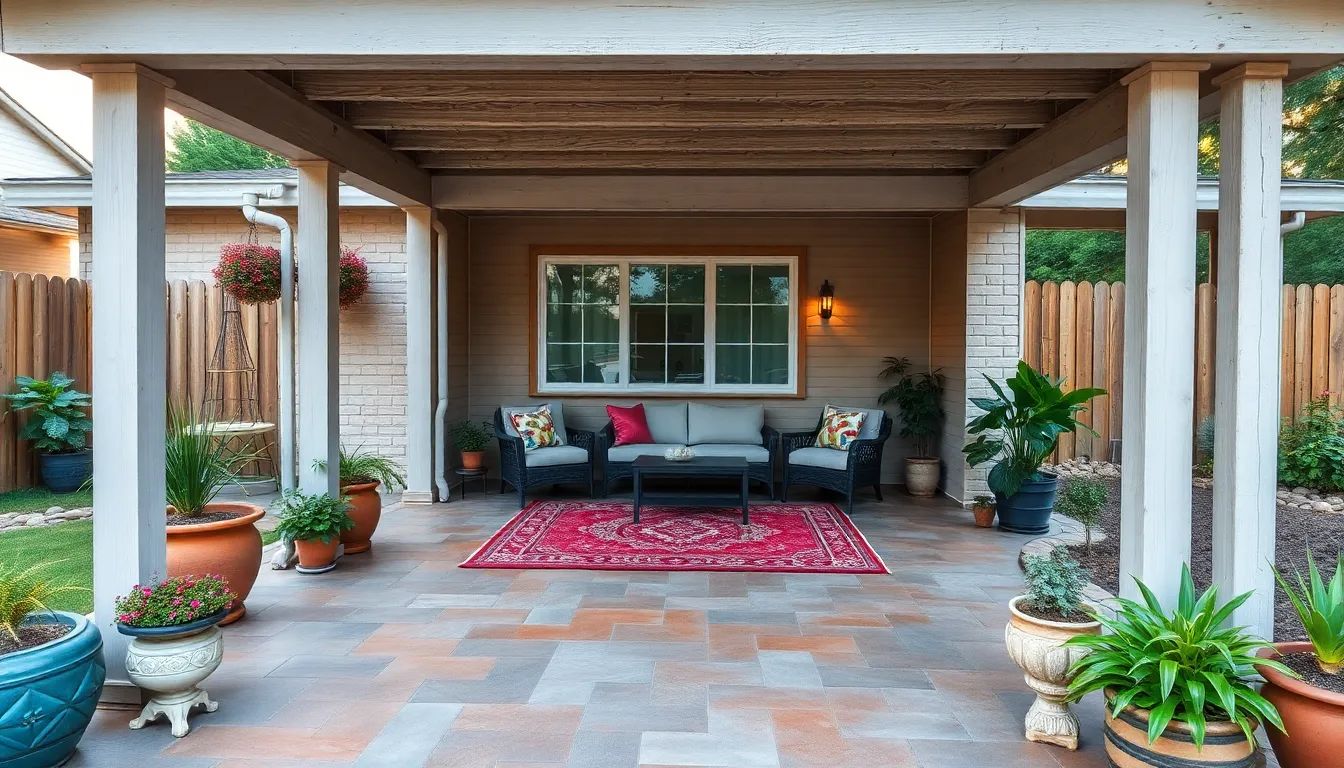
After establishing your covered patio structure, the right flooring transforms the space into a comfortable outdoor room. We’ll explore three budget-friendly flooring answers that deliver professional results without the professional price tag.
Lay Outdoor Rugs Over Existing Surfaces
Outdoor rugs instantly upgrade any patio floor for minimal cost, adding color, texture, and comfort without requiring replacement flooring. We can layer multiple smaller rugs to cover larger areas or choose one statement piece that defines the seating area. Weather-resistant materials like polypropylene or recycled plastic withstand moisture, UV rays, and heavy foot traffic while maintaining their appearance season after season.
Pattern mixing creates visual interest when we combine solid colors with geometric designs or natural textures. Placement strategies include centering rugs under furniture groupings or using runners to define walkways between different patio zones. Maintenance involves simple hosing down and occasional scrubbing with mild soap, making outdoor rugs a practical choice for busy households.
Install Interlocking Deck Tiles
Interlocking deck tiles offer easy installation without professional help, available in wood or composite materials that provide durability and weather resistance. We can transform concrete slabs, existing decking, or even level ground into attractive flooring in just a few hours. Composite options resist fading, staining, and moisture damage while requiring minimal maintenance throughout their lifespan.
Installation begins with cleaning and leveling the existing surface, followed by starting from one corner and working across in straight rows. Wood tiles bring natural warmth and can be stained or sealed to match existing outdoor furniture, while composite tiles come in many colors and textures that mimic expensive hardwood or stone. Most systems feature a snap-together design that accommodates slight surface irregularities and allows for easy replacement of individual tiles if needed.
Apply Concrete Stain for Updated Looks
Concrete staining provides an inexpensive way to add color and style to existing concrete patios, improving aesthetics without the cost of replacement or new flooring installation. We can choose from acid-based stains that create unique, mottled patterns or water-based stains that offer consistent, uniform color coverage. Preparation involves cleaning the concrete thoroughly and etching the surface to ensure proper stain penetration and adhesion.
Design possibilities include creating geometric patterns with painter’s tape, mimicking natural stone with multiple stain colors, or achieving a simple, elegant single-tone finish. Application requires basic tools like brushes, rollers, or pump sprayers, depending on the desired effect and coverage area. Sealing the stained concrete protects the finish from weather damage and foot traffic while adding a subtle sheen that enhances the color depth and richness.
Smart Shopping Tips for Maximum Savings
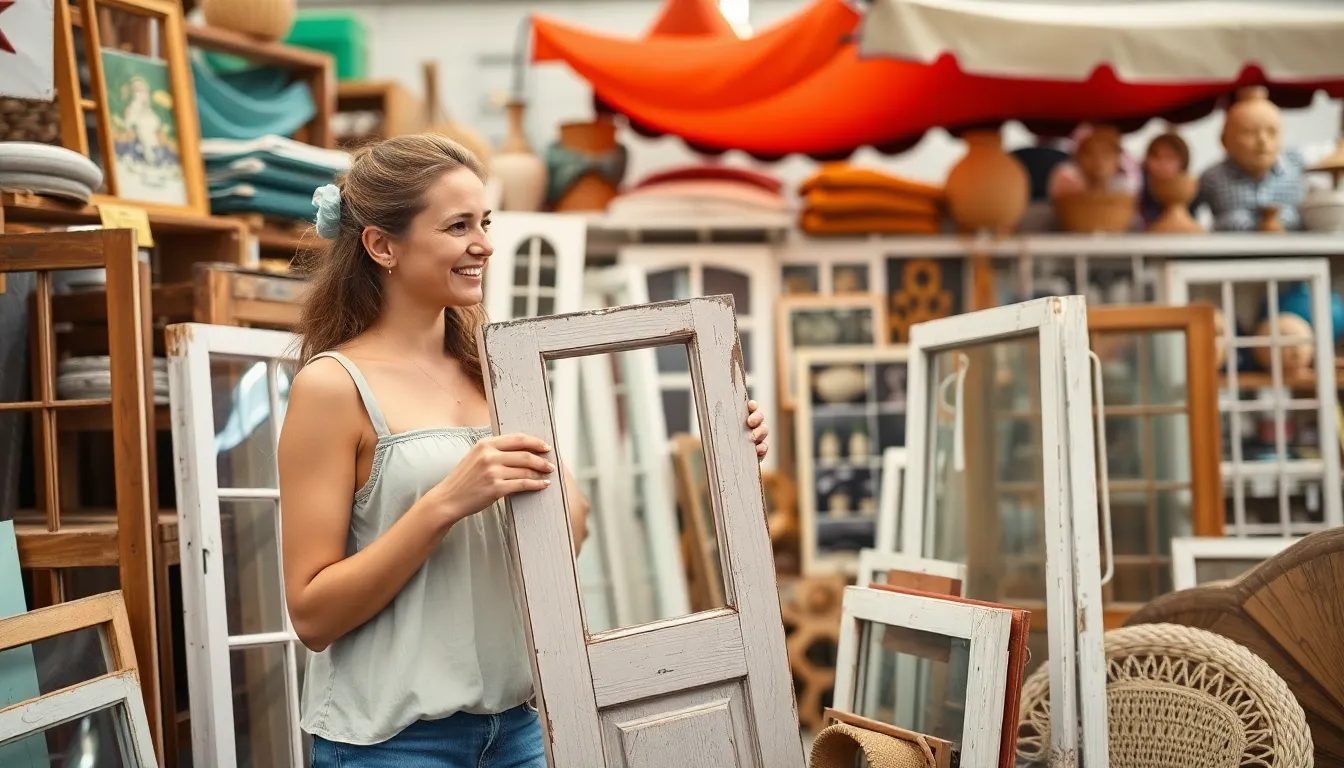
Strategic shopping can reduce your covered patio project costs by 40-60% when you know where and when to buy materials. We’ve compiled proven strategies that help you maximize savings without compromising quality.
Shop End-of-Season Sales for Materials
Timing your purchases around seasonal clearances delivers substantial savings on patio materials. We recommend shopping for lumber, fabric, and outdoor hardware during late summer and early fall when retailers clear inventory at 30-50% discounts.
End-of-season sales typically occur between August and October when stores make room for indoor seasonal merchandise. Hardware stores often discount pressure-treated lumber, corrugated panels, and outdoor fabrics during these periods.
Planning ahead for next year’s projects allows you to stockpile materials at clearance prices. We suggest storing lumber in a dry location and protecting fabric materials from moisture to maintain their quality until construction begins.
Check Thrift Stores for Repurposable Items
Thrift stores offer unexpected treasures for creative patio covers including old doors, windows, and metal awnings that can be transformed into functional shade structures. We’ve found vintage shutters, large tablecloths, and even shower curtains that work perfectly for fabric canopies.
Salvage yards provide weather-resistant metal materials and architectural elements at fraction of retail costs. These locations often stock corrugated metal sheets, wooden beams, and hardware that can be repurposed for lean-to covers or pergola construction.
Estate sales present opportunities to find outdoor umbrellas, canvas materials, and even complete patio furniture sets that complement your covered space. We recommend inspecting items carefully for structural integrity before purchasing.
Buy Materials in Bulk for Better Prices
Bulk purchasing reduces per-unit costs significantly when planning larger patio covers or multiple outdoor projects. We’ve seen savings of 20-30% when buying lumber bundles rather than individual boards from home improvement stores.
Wholesale lumber yards offer better pricing than retail stores for projects requiring substantial amounts of wood. These suppliers typically sell pressure-treated lumber and cedar materials in bulk quantities perfect for pergola construction.
Group buying with neighbors or friends amplifies savings potential when everyone needs similar materials. We suggest coordinating purchases of screws, brackets, and roofing materials to reach bulk pricing thresholds while splitting costs among multiple households.
Conclusion
Creating your dream covered patio doesn’t require very costly or hiring expensive contractors. We’ve shown you that with creativity and smart planning you can transform your outdoor space for just a few hundred dollars.
From DIY pergolas and fabric answers to permanent roof extensions and flexible shade options we’ve covered practical approaches that deliver real results. The key is choosing materials and methods that match your skills budget and style preferences.
Remember that smart shopping strategies can cut your costs significantly while still achieving professional-looking results. Whether you’re starting with a simple tarp setup or building a complete lean-to structure these budget-friendly ideas prove that everyone can enjoy a beautiful covered patio.
Your outdoor oasis is just one weekend project away – and your wallet will thank you for it.
Frequently Asked Questions
What’s the average cost to create a budget-friendly covered patio?
You can create a beautiful covered patio for under $500 using DIY solutions. Basic pergola structures cost $200-400, while creative alternatives like fabric covers or repurposed materials can be implemented for as little as $30-100. The key is choosing the right approach for your space and skill level.
How do I build a DIY pergola on a budget?
Use pressure-treated lumber for the frame with concrete footings for stability. Plan for 8-foot posts with 2×8 beams, securing connections with galvanized carriage bolts. Add retractable shade cloth and consider planting climbing vines for natural coverage. Most weekend DIYers can complete this project successfully.
What materials can I repurpose for patio covers?
Old bed sheets treated with fabric sealant make excellent weather-resistant canopies. Heavy-duty tarps provide instant coverage, while outdoor umbrellas can be converted to permanent fixtures. Canvas drop cloths, indoor curtains, and painter’s canvas also work well for creative shade solutions.
Are lean-to patio covers difficult to build?
No, lean-to covers are beginner-friendly structures that utilize your home’s existing wall for support. Using basic lumber and corrugated panels, you can build one for under $200. They’re perfect for providing shade and rain protection with minimal construction experience required.
What are the most affordable fabric covering options?
Canvas drop cloths stretched across simple frames cost under $30. Outdoor curtains on wire systems offer adaptable coverage, while repurposed indoor curtains work for budget installations. Marine-grade vinyl provides durability, and painter’s canvas offers a rustic, cost-effective aesthetic.
How can I add lighting to my covered patio cheaply?
Solar-powered LED string lights provide cost-effective illumination without electrical work. Battery-operated lanterns offer flexible placement options, while DIY mason jar light fixtures add charm. These solutions create inviting evening ambiance without significant investment or professional installation.
What flooring options work best for covered patios?
Outdoor rugs instantly add color and comfort over existing surfaces. Interlocking deck tiles provide easy installation and attractive results. Concrete stain can update existing concrete patios affordably. Each option delivers professional-looking results while maintaining budget-friendly costs.
When should I shop for patio materials to save money?
Shop during end-of-season sales for 40-60% discounts on materials. Check thrift stores for repurposable items and buy in bulk to reduce per-unit costs. Late fall and winter typically offer the best deals on outdoor furniture and construction materials.

